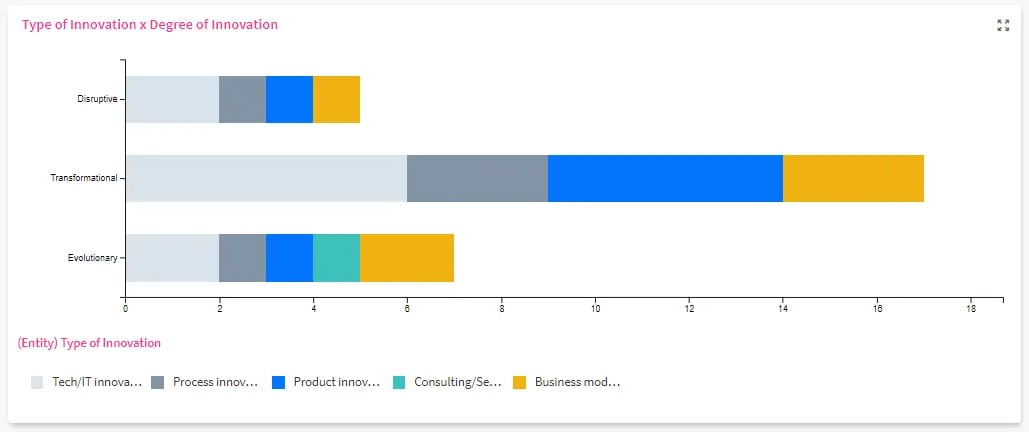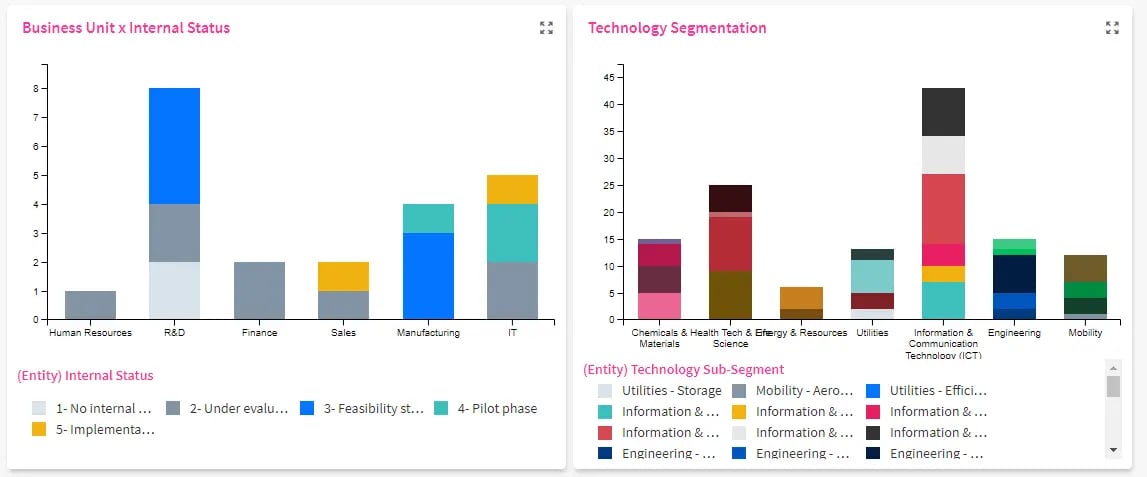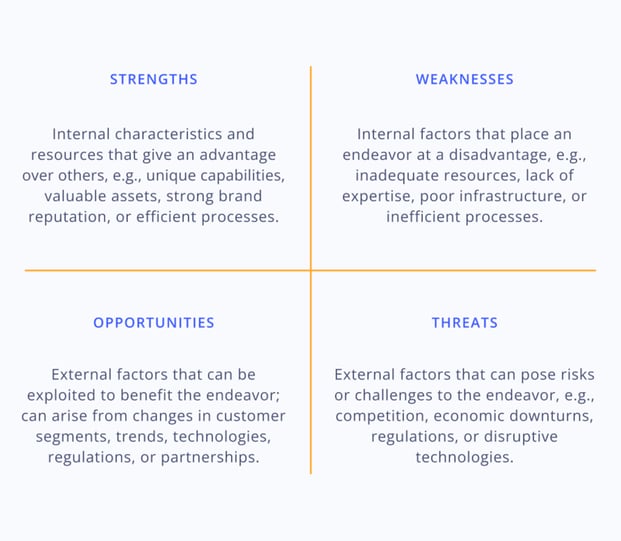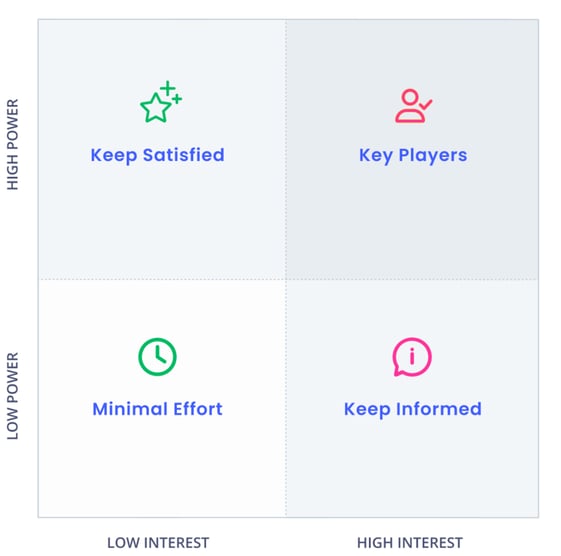Good innovation governance is the grease that keeps the engine of innovation running smoothly. It ensures accountability, transparency, engagement, and continuity in innovation. It’s what ensures effective orchestration of the various stages of innovation, streamlining and amplifying the impact of strategic foresight, idea management, and innovation portfolio management.
In this blog, we explore ten of the most important innovation governance methods to help your organization connect the dots from strategy to execution. Read on to learn how to build a framework for agile, collaborative, and continuous innovation by operationalizing these best-practice methods in a single end-to-end operating system.
1. Roles and promoters
Defining clear roles as part of innovation governance provides a structured framework and foundation for effective coordination, efficient resource allocation, alignment, and accountability. Key roles in innovation governance may include innovation managers, cross-functional teams, a governance board or committee, and promoters.
Specifically, the promoter model recommends four distinct types of promoters: project sponsors, project champions, technology or specialist promoters, and relationship promoters or networkers. Establishing these roles within an innovation team nurtures a culture of innovation and provides the necessary support to encourage engagement and collaboration for better innovation outcomes.
2. Dashboards
Innovation dashboards visually represent data and information that provide a concise and intuitive overview of key performance indicators (KPIs), metrics, and insights. They are designed to offer a real-time snapshot of important aspects related to an organization’s innovation program, enabling quick and informed decision-making.
Dashboards enable the tracking of key innovation metrics and KPIs, such as the number of new ideas generated, the success rate of implemented innovations, R&D expenditures, and resource allocation. By displaying strategic goals and targets alongside progress, they can help ensure innovation efforts are on track and are contributing to the overall strategic direction.


With dashboards in ITONICS, you can easily configure a variety of data visualizations and charts to quickly focus on what matters most to your organization’s strategic growth. Personalized views tailored to specific objectives help teams and decision-makers efficiently track innovation progress, identify bottlenecks, and optimize resource allocation.
Learn more about enhancing decision-making with custom dashboards →
3. Benchmarking profile
A benchmarking profile refers to a set of standards, metrics, or performance indicators used to assess and compare the performance of a particular asset, innovation, or initiative against industry best practices or competitors. It involves measuring and evaluating various aspects of performance to identify areas of improvement, set targets, and track progress over time.
By establishing benchmarking profiles, organizations can compare the health and performance of their innovation portfolio with industry standards, previous performance, or competitors' portfolios. This allows them to identify areas where they are underperforming or falling behind, as well as areas where they excel.
With ITONICS, you can easily establish benchmarking profiles to monitor your innovation assets and improve your portfolio's performance. Download our free Innovation Framework & KPIs White Paper to learn more about important metrics for providing oversight, justifying innovation investments, and informing strategic decision-making.
4. Budget
Budgets play a vital role in innovation governance by providing a financial framework that guides resource allocation, decision-making, risk management, performance evaluation, and accountability in the pursuit of innovation within an organization.
The management of an innovation budget typically involves several key stakeholders within an organization, including leadership, innovation teams, and the finance department. It requires effective communication, analysis of resource needs, monitoring of expenses, and flexibility to adapt as the organization's innovation landscape evolves.
5. Growth boards
A growth board is a specialized board or committee that focuses specifically on driving innovation and growth within an organization. It brings together individuals with diverse backgrounds, expertise, and perspectives, including executives, board members, innovation experts, and possibly external advisors.
A growth board is typically formed to provide dedicated oversight, guidance, and support for innovation initiatives with the goal of fostering a culture of continuous improvement, exploration of new ideas, and strategic innovation. It is responsible for ensuring that the entire organization maintains a balanced portfolio of growth initiatives across each of the Three Horizons.
Innovation growth boards at Moody’s Analytics: the why, what, and how
- Why? Moody’s Analytics has embraced the growth board model to bring accountability and venture capital-style funding into the innovation process at the enterprise level. This approach promotes agility and mitigates risk by balancing resource allocation across horizons.
- What? The growth board is made up of members of the executive leadership team, with representatives from finance, HR, strategy, IT, Moody's Analytics, and Moody's Investor Service. There is also an external advisor to bring in outside perspectives. It is important that these members have decision-making authority as well as the right mindset to interrogate and experiment.
- How? The growth board uses a metered funding model in which early-stage ideas are financed over a series of rounds. All decisions relating to allocations are based on goals and milestones. In earlier funding stages, goals are learning-based, while in the later rounds, goals and funding are growth-based.
6. SWOT analysis
A SWOT analysis is a strategic planning tool used to evaluate the strengths, weaknesses, opportunities, and threats of an asset or process. It involves identifying and analyzing internal and external factors that can impact the success of an endeavor.
SWOT analysis can provide a framework for benchmarking your organization's innovation management process. It prompts evaluation of internal strengths and weaknesses in innovation capabilities, as well as external opportunities and threats that may impact the organization's innovative efforts. This steers decision-making and the development of effective strategies to enhance innovation management performance.

7. Mendelow stakeholder matrix
The Mendelow stakeholder matrix is a tool used to analyze and categorize stakeholders based on their level of interest and power/influence over a particular project or organization. It is a valuable tool for understanding the attitudes, expectations, and potential impact of different stakeholders and managing these relationships to ensure effective innovation governance.
When applied to innovation governance, the matrix helps organizations effectively manage stakeholder relationships, prioritize engagement efforts, and navigate potential obstacles, thereby enhancing the overall success of innovation initiatives.

8. VRIO framework
The VRIO framework is a strategic management tool used to assess an organization’s internal resources and capabilities to determine its competitive advantage. VRIO stands for value, rarity, imitability, and organization. Each of these aspects is evaluated to determine whether a resource or capability can provide sustained competitive advantage.
By analyzing each component, organizations can understand how to leverage their internal resources effectively and make strategic decisions based on their competitive position.
Developing an effective innovation program starts with an assessment of your current situation. Take our ITONICS Innovation Maturity Assessment to benchmark your organization's innovation maturity, identify gaps, and optimize your innovation program for success.
9. Events
Events play a crucial role in innovation governance by facilitating knowledge exchange, idea generation, collaboration, and feedback. They provide a platform for individuals and organizations to share insights, best practices, and experiences related to innovation.
Events foster networking and collaboration, leading to the formation of innovation ecosystems and supportive communities. They inspire and motivate participants by showcasing success stories and transformative technologies, influencing the direction of innovation governance.
Get to know us, the ITONICS Innovation OS, and other innovation rockstars at upcoming events, conferences, or meetups.
10. Software
Innovation management software helps organizations digitalize innovation activities for gains in efficiency, time and cost savings, and improved outcomes.
But unlike traditional and often fragmented innovation management software, the ITONICS Innovation OS combines human ingenuity and machine intelligence in a single collaborative operating system, centralizing information, automating tasks, and connecting the dots from strategy to execution—so you can innovate fast, systematically, and continuously.
Build an innovation governance framework for success
Innovation governance sets you up for success by providing a structured approach to managing innovation activities, aligning them with strategic objectives, optimizing resource allocation, managing risks, and fostering a culture of innovation. It ensures that innovation efforts are purposeful, well-managed, and more likely to yield positive results.
To get started, organizations need to identify the right mix of governance methods that match their needs. Typically the responsibility of a Chief Innovation Officer, building a governance toolbox requires careful consideration of the organization’s goals, specific challenges, and team capabilities.
Chief Innovation Officers and innovation teams can use the ITONICS Innovation Toolbox to help select the methods that will support their governance framework. The toolbox contains the methods mentioned here, along with many more best-practice tools, techniques, and concepts for elevating innovation governance practices, as well as foresight, ideation, and innovation portfolio management. Each method is interlinked with solutions, templates, and tips from the ITONICS Innovation OS to quickly put your innovation plans into practice.
Innovate continuously with ITONICS
The ITONICS Innovation OS anchors your entire end2end innovation ecosystem in a single point of truth. Underpinning all of this is a built-in governance framework, fully configurable to your organization’s unique set of needs and scalable to accommodate your ever-changing innovation ecosystem as you accelerate, increase complexity, and add stakeholders.
- Define and assign clear roles and permissions as part of your organization’s innovation governance structure.
- Establish benchmarking profiles to monitor your innovation assets and improve your portfolio's performance.
- Configure a variety of data visualizations and charts to focus on what matters most to your organization’s strategic growth.
- Link budgets to innovation activities, manage resources, and track progress effectively.
- Plan capacities and FTEs and provide transparency to elevate your innovation teams’ performance.
Want to learn more about how ITONICS makes innovation governance easy, freeing you to focus on more creative and strategic aspects of innovation? Book a free demo and see for yourself!











